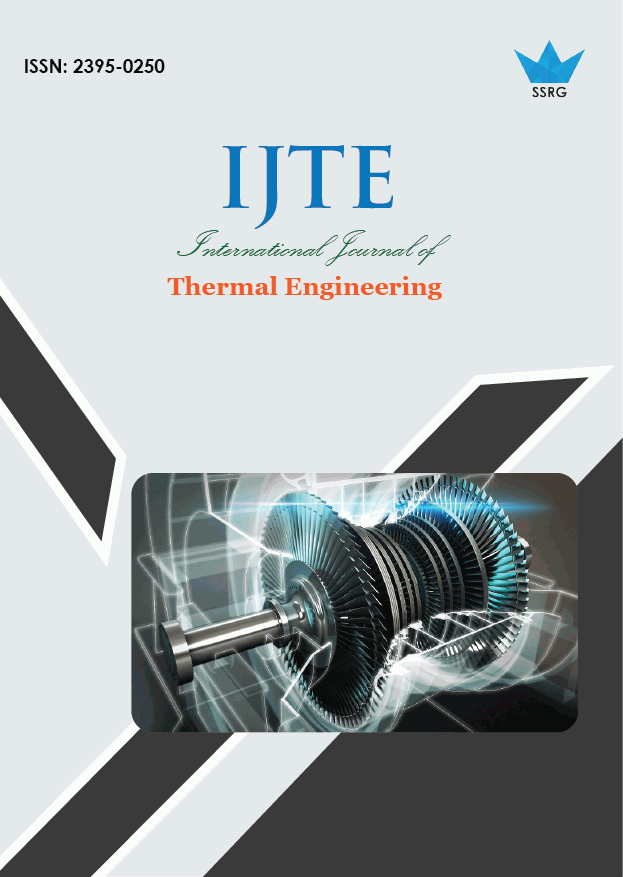The Impact of Surrounding Temperature on Performance Analysis of Simple Air Standard Brayton Cycle

| International Journal of Thermal Engineering |
| © 2017 by SSRG - IJTE Journal |
| Volume 3 Issue 2 |
| Year of Publication : 2017 |
| Authors : Muthuraman Subbiah |
How to Cite?
Muthuraman Subbiah, "The Impact of Surrounding Temperature on Performance Analysis of Simple Air Standard Brayton Cycle," SSRG International Journal of Thermal Engineering, vol. 3, no. 2, pp. 8-11, 2017. Crossref, https://doi.org/10.14445/23950250/IJTE-V3I3P101
Abstract:
In this study, the execution examination of the straightforward Brayton cycle is considered. The net power and aggregate productivity of framework are picked as the execution criteria. The variable parameters chose for investigation are the compressor weight proportion and encompassing temperature. The others variables are accepted consistent. The conditions for ascertaining the force and productivity are defined as an element of these choice variables. Accordingly, created model has been explained and the outline conditions giving most extreme force and efficiency have been resolved.
Keywords:
Performance analysis, Efficiency, Power, Brayton Cycle.
References:
1. Najjar, Y.S.H., “Efficient Use of Energy by Utilizing Gas Turbine Combined Systems”, Applied Thermal Engineering, 21: 407-438, (2001).
2. Najjar, Y.S.H., “Gas Turbine Cogeneration Systems: A Review of Some Novel Cycles”,Applied Thermal Engineering, 20: 179-197, (2000).
3. M. Ameri, S.H. Hejazi, K. Montaser, “Performance and Economic of The Thermal Energy Storage Systems to Enhance The Peaking Capacity of The Gas Turbines”, Applied Thermal Engineering, 25: 241-251, (2005).
4. Teppenstall, T., “Advanced Gas Turbine Cycles for Power Generation: A Critical Review”, Applied Thermal Engineering, 18: 837-846, (1998).
5. Çetinkaya, S., GazTürbinleri, Nobel Yayınları, (1999).
6. Shukla, A.K., Singh, O., “Performance Evaluation of Steam Injected Gas Turbine Based Power Plant with Inlet Evaporative Cooling”, Applied Thermal Engineering, 102: 454–464, (2016).
7. Çengel, Y.A., Boles, M.A., Termodinamik: MühendislikYaklaşımıyla, GüvenKitabevi, (2008).
8. De Paepe, M., Dick, E., “Cycle İmprovements to Steam İnjected Gas Turbines”, International Journal of Energy Research, 24(12): 1081-1107, (2000).
9. J.H. Horlock, “Aero-engine Derivative Gas Turbines for Power Generation: Thermodynamic and Economic Perspectives”, Journal of Engineering for Gas Turbines and Power, 119: 119-123, (1997).
10. Sa, A.D., Zubaidy, S.A., “Gas Turbine Performance at Varying Ambient Temperature”, Applied Thermal Engineering, 31: 2735-2739, (2011).
11. Zhang, W., Lingen, O., Fengrui, S., “Power and Efficiency Optimization for Combined Brayton and Inverse Brayton Cycles”, Applied Thermal Engineering, 29(14-15): 2885- 2894, (2009).
12. Basrawi, F., Yomada, T., Nakanishi K., Naing S., “Effect of Ambient Temperature on The Performance of Micro Gas Turbine with Cogeneration System in Cold Region”, Applied Thermal Engineering, 31 (6-7): 1058-1067, (2011).
13. Erdem, H.H., Sevilgen, S.H., “Case Study: Effect of Ambient Temperature on The Electricity Production and Fuel Consumption of a Simple Cycle Gas Turbine in Turkey”, Applied Thermal Engineering, 26 (2-3): 320-326, (2006).
14. Zadpoor, A.A., Golshan, A.H., “Performance Improvement of a Gas Turbine Cycle by Using a Desiccant-Based Evaporative Cooling System”, Energy, 31: 2652-2664, (2006).
15. Lee, J.J., Kang, D.W., Kim, T.S., “Development of a Gas Turbine Performance Analysis Program and its Application”, Energy, 36: 5274-5285, (2011).
16. Carniere, H., Willocx, A., Dick, E., Paepe, M.D., “Raising Cycle Efficiency by Inter Cooling in Air Cooled Gas Turbine”, Applied Thermal Engineering, 26 (16): 1780-1787, (2006).
17. Silveira, J.L., Tuna, ,C.E. “Thermoeconomic Analysis Method for Optimization of Combined Heat and Power Systems”,Progress in Energy and Combustion Science,29: 479-485, (2003).

 10.14445/23950250/IJTE-V3I3P101
10.14445/23950250/IJTE-V3I3P101